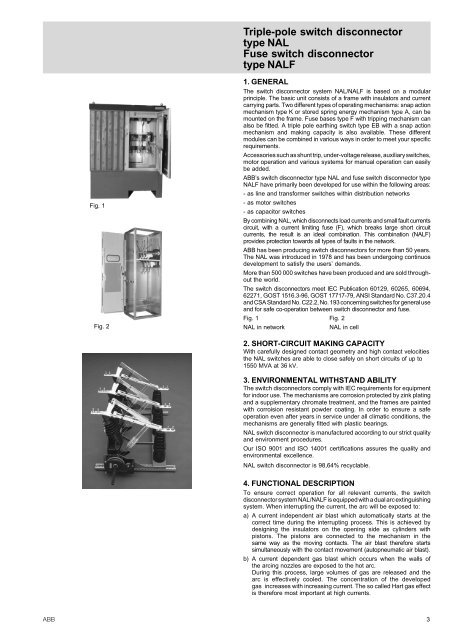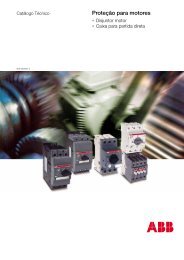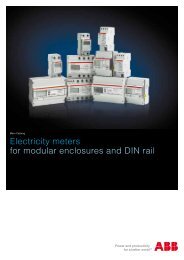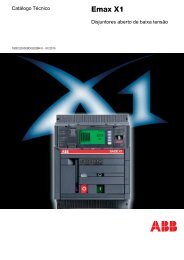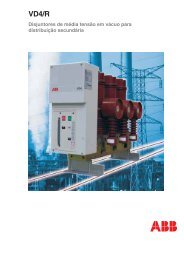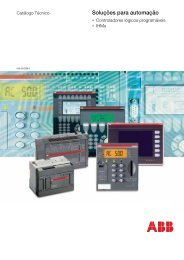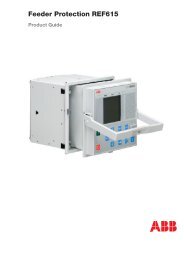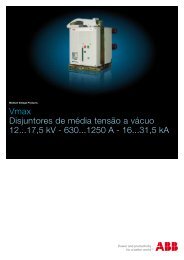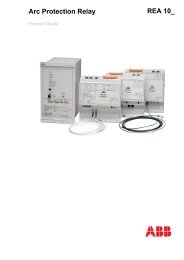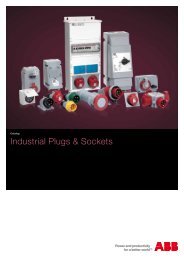Indoor Air Switch Disconnector, NAL Indoor Air Switch Disconnector ...
Indoor Air Switch Disconnector, NAL Indoor Air Switch Disconnector ...
Indoor Air Switch Disconnector, NAL Indoor Air Switch Disconnector ...
- No tags were found...
Create successful ePaper yourself
Turn your PDF publications into a flip-book with our unique Google optimized e-Paper software.
Triple-pole switch disconnectortype <strong>NAL</strong>Fuse switch disconnectortype <strong>NAL</strong>FFig. 1Fig. 21. GENERALThe switch disconnector system <strong>NAL</strong>/<strong>NAL</strong>F is based on a modularprinciple. The basic unit consists of a frame with insulators and currentcarrying parts. Two different types of operating mechanisms: snap actionmechanism type K or stored spring energy mechanism type A, can bemounted on the frame. Fuse bases type F with tripping mechanism canalso be fitted. A triple pole earthing switch type EB with a snap actionmechanism and making capacity is also available. These differentmodules can be combined in various ways in order to meet your specificrequirements.Accessories such as shunt trip, under-voltage release, auxiliary switches,motor operation and various systems for manual operation can easilybe added.ABB’s switch disconnector type <strong>NAL</strong> and fuse switch disconnector type<strong>NAL</strong>F have primarily been developed for use within the following areas:- as line and transformer switches within distribution networks- as motor switches- as capacitor switchesBy combining <strong>NAL</strong>, which disconnects load currents and small fault currentscircuit, with a current limiting fuse (F), which breaks large short circuitcurrents, the result is an ideal combination. This combination (<strong>NAL</strong>F)provides protection towards all types of faults in the network.ABB has been producing switch disconnectors for more than 50 years.The <strong>NAL</strong> was introduced in 1978 and has been undergoing continuosdevelopment to satisfy the users’ demands.More than 500 000 switches have been produced and are sold throughoutthe world.The switch disconnectors meet IEC Publication 60129, 60265, 60694,62271, GOST 1516.3-96, GOST 17717-79, ANSI Standard No. C37.20.4and CSA Standard No. C22.2, No. 193 concerning switches for general useand for safe co-operation between switch disconnector and fuse.Fig. 1 Fig. 2<strong>NAL</strong> in network<strong>NAL</strong> in cell2. SHORT-CIRCUIT MAKING CAPACITYWith carefully designed contact geometry and high contact velocitiesthe <strong>NAL</strong> switches are able to close safely on short circuits of up to1550 MVA at 36 kV.3. ENVIRONMENTAL WITHSTAND ABILITYThe switch disconnectors comply with IEC requirements for equipmentfor indoor use. The mechanisms are corrosion protected by zink platingand a supplementary chromate treatment, and the frames are paintedwith corroision resistant powder coating. In order to ensure a safeoperation even after years in service under all climatic conditions, themechanisms are generally fitted with plastic bearings.<strong>NAL</strong> switch disconnector is manufactured according to our strict qualityand environment procedures.Our ISO 9001 and ISO 14001 certifications assures the quality andenvironmental excellence.<strong>NAL</strong> switch disconnector is 98,64% recyclable.4. FUNCTIO<strong>NAL</strong> DESCRIPTIONTo ensure correct operation for all relevant currents, the switchdisconnector system <strong>NAL</strong>/<strong>NAL</strong>F is equipped with a dual arc extinguishingsystem. When interrupting the current, the arc will be exposed to:a) A current independent air blast which automatically starts at thecorrect time during the interrupting process. This is achieved bydesigning the insulators on the opening side as cylinders withpistons. The pistons are connected to the mechanism in thesame way as the moving contacts. The air blast therefore startssimultaneously with the contact movement (autopneumatic air blast).b) A current dependent gas blast which occurs when the walls ofthe arcing nozzles are exposed to the hot arc.During this process, large volumes of gas are released and thearc is effectively cooled. The concentration of the developedgas increases with increasing current. The so called Hart gas effectis therefore most important at high currents.ABB 3


